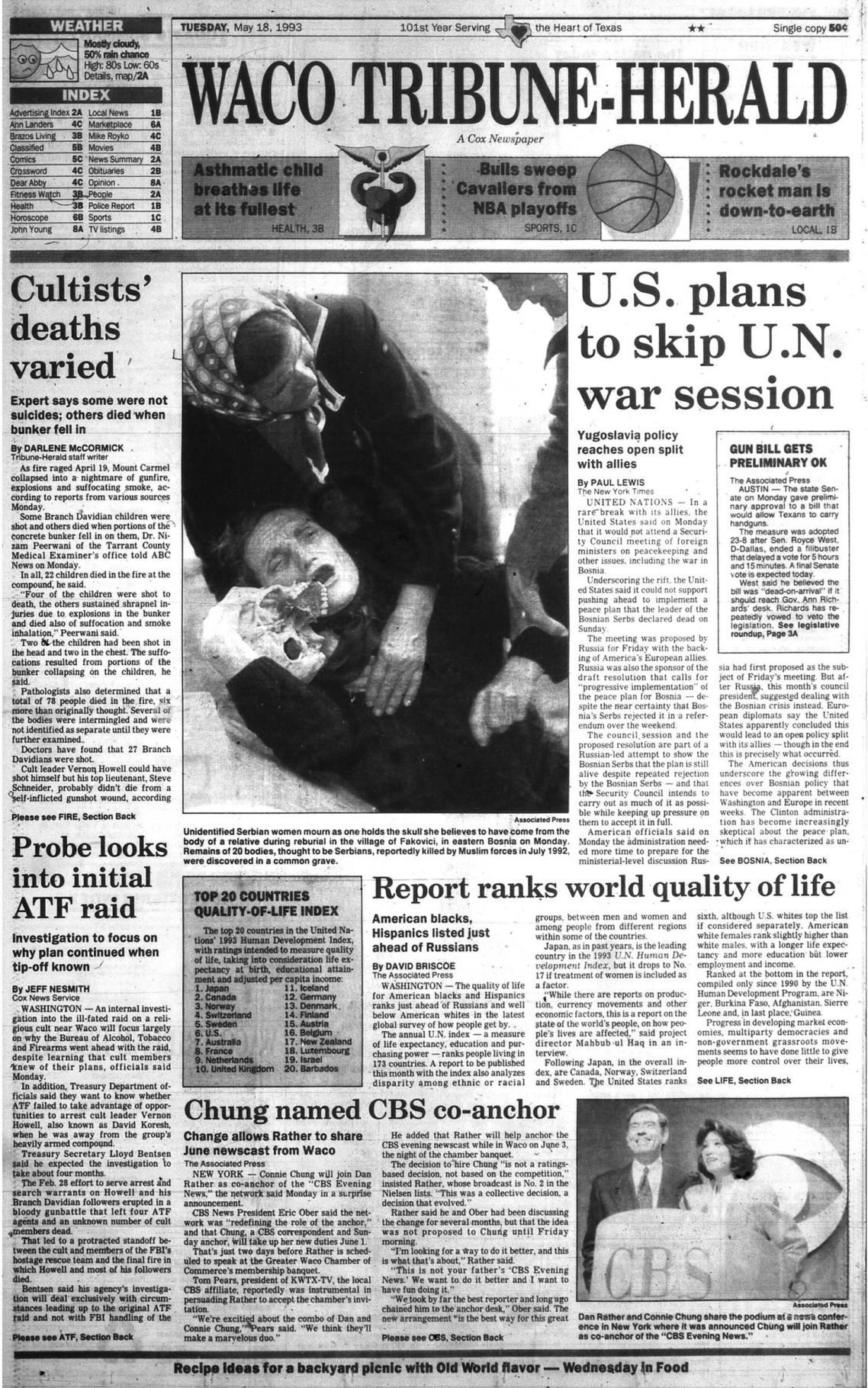As fire raged April 19, Mount Carmel collapsed into a nightmare of gunfire, explosions and suffocating smoke, according to reports from various sources Monday.
Some Branch Davidian children were shot and others died when portions of the concrete bunker fell in on them, Dr. Nizam Peerwani of the Tarrant County Medical Examiner’s office told ABC News on Monday.
In all, 22 children died in the fires at the compound, he said.
“Four of the children were shot to death, the others sustained shrapnel injuries due to explosions in the bunker and died also of suffocation and smoke inhalation,” Peerwani said.
Two of the children had been shot in the head and two in the chest. The suffocations resulted from portions of the bunker collapsing on the children, he said.
Pathologists also determined that a total of 78 people died in the fire, six more than originally thought. Several of the bodies were intermingled and were not identified as separate until they were further examined.
Doctors found that 27 Branch Davidians were shot.
Cult leader Vernon Howell could have shot himself but his top lieutenant, Steve Schneider, probably didn’t die from a self-inflicted gunshot wound, according to an independent pathologist who examined the bodies over the weekend.
Dr. Cyril Wecht of Pittsburgh, who has been a consulting pathologist in such cases as the assassination of President John F. Kennedy, said Monday he does not think Schneider’s wound was self-inflicted.
Wecht examined the charred corpses of Howell, Schneider and his wife, Judy Schneider-Koresh, for about three hours Saturday in Fort Worth. He was retained by families of the Branch Davidians who died in the conclusion to the 51-day siege at Mount Carmel.
The initial, and official, autopsies were performed by the Tarrant County Medical Examiner’s office.
“With Schneider, the gunshot wound is based in the back of the head,” Wecht said, adding the bullet traveled upward through the head. “That, as far as I’m concerned, is not a self-inflicted wound.”
In Howell’s case, the issue isn’t as clear, he said.
“I looked at the angle . . . it wasn’t an impossible shot,” Wecht said. “Is it physically possible? Yes, it is.”
But Wecht said it is not the customary wound found in a suicide. The bullet entered the center of the forehead and exited about an inch to the right of the center in the rear of the skull, he said.
“I have said it is not among the more frequently encountered . . . suicide wounds,” he said.
Officials have said Howell, also known as David Koresh, died from a gunshot wound to the head.
Schneider died from smoke inhalation and possibly a gunshot wound to the head.
No cause of death has been released on Schneider-Koresh, who was legally married to Steve Schneider but was the mother of one of Howell’s children. During the siege, she identified herself to authorities as Judy Schneider-Koresh.
On Monday, David Thibodeau, a cult member who survived the fire, said that cult members did not have a suicide pact.
Thibodeau told “CBS This Morning” that cult members may have shot themselves or others out of desperation as fire raged through the compound.
“People caught in a fire would rather take the easy way out,” he said.
Wecht cautioned that his findings are not final. There has been no official ruling on whether the gunshot wounds were self-inflicted, he said, or even whether the bullets caused death.
McLennan County Justice of the Peace David Pareya said he could not comment on Wecht’s opinions on the gunshot wounds.
“Apparently, he’s privy to some information we have not received,” he said. “We have to have the full report from the medical examiner’s office to come to our own conclusion.”
Wecht said that he is not sure of the cause of death for Howell or Schneider.
“The gunshot wound in both Koresh and Schneider could have been fatal,” he said, but added he wants to see toxicology reports before giving his final opinion.
While he agrees with the official autopsy report on the position of the gunshot wound in Howell’s head, Wecht said he cannot tell if Howell died from a bullet.
“I do not confirm or disagree,” he said, adding that the carbon monoxide levels in the bloodstream at the time of death would give him a better idea. These levels will show whether Howell and others were shot before, during or after the fire, he said.
Peerwani last week dismissed the notion that Howell, or any other cult member, could have been killed by a bullet that spontaneously exploded in the fire. He said those bullets wouldn’t have had the velocity to kill.
But Peerwani said he is sure Howell was killed by the bullet fired into his head and not shot after he died in the fire.
“We can easily show that by the burning patterns,” he said. “So we have absolutely no reservations that the burning took place after the shot.”
If Peerwani is correct, that would mean that Howell shot himself or was shot by someone else before the fire could kill him.












